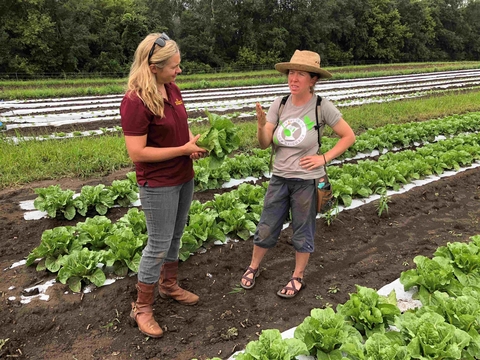Irrigation water can affect produce safety and pose a health risk to consumers if not managed.
Produce growers who use water for irrigation and applying crop sprays have struggled to identify and prioritize the risks associated with their water sources. A new tool makes on-the-spot evaluation using direct observations a lot simpler.
The tool helps produce farmers understand and manage risks to agricultural water used to irrigate fresh fruits and vegetables. Developed by Annalisa Hultberg, University of Minnesota; Phil Tocco, Michigan State University; and Don Stoeckel, Produce Safety Alliance, the nation's first Excel-based risk assessment ranking tool is the result of a three-year project.
“Previously, growers have largely relied on E. coli tests to understand their water source, but testing can be expensive and there is a lag before getting results,” says Hultberg, University of Minnesota Extension food safety educator.
Also, federal regulations from the FDA Food Safety Modernization Act for pre-harvest water have recently been revised to require a detailed risk assessment of on-farm water sources. These regulations include requirements that produce growers understand the landscape-level risks to their water sources.
“This tool can help farmers understand those risks,” says Phil Tocco, Extension food safety educator at Michigan State University. “The tool walks growers through the complex web of potential risk factors to their irrigation water sources that may cause microbial contamination to the crops, and then gives the user a numeric risk score.”
Factors include the number of wild or domestic animals on the landscape around the water source, if there have been heavy rains, if the septic has been maintained, or if local geology impacts the aquifer.
E.coli numbers are expected to rise where there is more fecal contamination. To test the tool, the project team compared risk tool scores to the E. coli data and confirmed that the tool effectively represents fecal contamination in Michigan and Minnesota water sources. The team has piloted the tool with farmers in Vermont, Iowa, Ohio, Minnesota, Michigan and Hawaii to ensure its user interface is sound.
A paper version of the tool has been developed for use by Amish and Plain community growers, an important sector of the produce growing community.
“Produce farmers' understanding and managing risks to agricultural water is critical to ensure safe produce. This tool offers actionable data to assess risks and implement effective mitigation strategies, which can help improve the safety of our food supply,” says Nicole Baysal, Minnesota Department of Agriculture Produce Safety Program manager.
Next steps include validating the tool to include water sources from other growing regions, such as the desert southwest, where risks and uses of water vary from the Upper Midwest.
The Risk Prioritization Tool for Agricultural Water tool can be downloaded here and is free to use and share.
Permission is granted to news media to republish our news articles with credit to University of Minnesota Extension. Images also may be republished; please check for specific photographer credits or limited use restrictions in the photo title.


